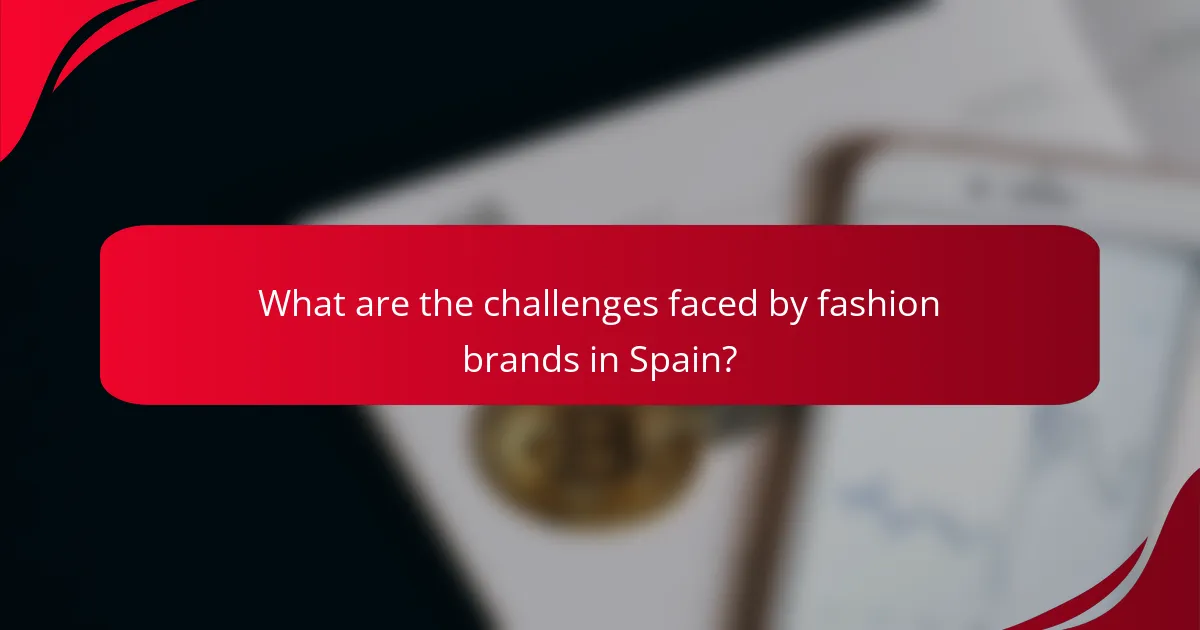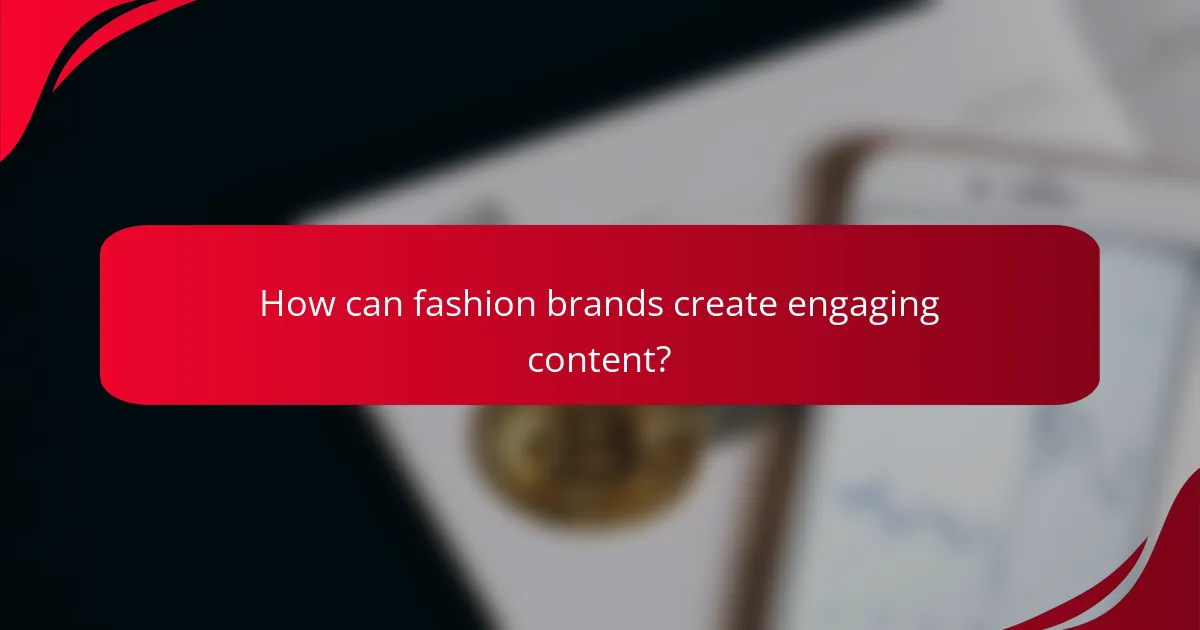In the competitive landscape of fashion in Spain, brands can thrive by employing a diverse range of content marketing approaches. Strategies such as influencer collaborations, targeted social media advertising, and SEO optimization not only boost brand visibility but also cultivate customer loyalty. By tailoring content to resonate with local audiences, fashion brands can effectively engage consumers and drive sales.

What content marketing strategies work for fashion brands in Spain?
Fashion brands in Spain can effectively engage their audience through a mix of influencer collaborations, social media advertising, content personalization, and video marketing campaigns. These strategies not only enhance brand visibility but also foster customer loyalty and drive sales.
Influencer collaborations
Influencer collaborations are a powerful way for fashion brands in Spain to reach targeted audiences. By partnering with local influencers who resonate with their brand values, companies can leverage their followers’ trust and expand their market presence.
When selecting influencers, consider their engagement rates and audience demographics to ensure alignment with your brand. Micro-influencers often yield high engagement at lower costs, making them a viable option for many brands.
Social media advertising
Social media advertising is essential for fashion brands looking to capture attention in Spain’s competitive market. Platforms like Instagram and Facebook offer targeted advertising options that allow brands to reach specific demographics based on interests, behaviors, and location.
To maximize effectiveness, brands should create visually appealing ads that reflect their unique style and message. Regularly analyzing ad performance can help refine strategies and improve return on investment.
Content personalization
Content personalization enhances customer experience by tailoring messages and offers to individual preferences. Fashion brands in Spain can utilize data analytics to understand customer behavior and create personalized email campaigns, product recommendations, and website experiences.
Implementing personalization can significantly increase engagement and conversion rates. Brands should ensure they comply with data protection regulations, such as GDPR, when collecting and using customer data.
Video marketing campaigns
Video marketing campaigns are increasingly popular among fashion brands in Spain, as they effectively showcase products and tell brand stories. Engaging video content can be shared across various platforms, including social media and websites, to attract and retain customers.
Consider creating behind-the-scenes videos, styling tips, or customer testimonials to connect with your audience. Short, impactful videos often perform better, so aim for concise messaging that captures attention quickly.

How can fashion brands leverage social media in Spain?
Fashion brands in Spain can effectively leverage social media by creating engaging content that resonates with local audiences and utilizing targeted advertising strategies. Platforms like Instagram, Facebook, and TikTok offer unique opportunities to connect with consumers and enhance brand visibility.
Instagram engagement tactics
To maximize engagement on Instagram, fashion brands should focus on high-quality visuals and authentic storytelling. Utilizing features like Stories, Reels, and IGTV can help showcase products in dynamic ways, appealing to the visually-driven audience.
Brands can also encourage user-generated content by hosting contests or challenges, prompting followers to share their own styles using specific hashtags. This not only boosts engagement but also fosters a community around the brand.
Facebook advertising strategies
Facebook advertising allows fashion brands to target specific demographics and interests, making it a powerful tool for reaching potential customers in Spain. Brands should consider using carousel ads to showcase multiple products or collections, enhancing the likelihood of user interaction.
Additionally, retargeting ads can help re-engage users who have previously interacted with the brand’s website or social media, increasing conversion rates. Setting clear objectives and monitoring campaign performance is crucial for optimizing ad spend.
Utilizing TikTok for brand awareness
TikTok offers a unique platform for fashion brands to create viral content that boosts brand awareness. Short, creative videos that highlight trends, styling tips, or behind-the-scenes looks can capture the attention of younger audiences in Spain.
Brands should collaborate with popular TikTok influencers to reach wider audiences and leverage their established trust. Engaging in trending challenges or using popular sounds can further enhance visibility and encourage user participation.

What role does SEO play in content marketing for fashion brands?
SEO is crucial for content marketing in fashion brands as it enhances visibility and drives organic traffic to websites. By optimizing content for search engines, brands can attract potential customers actively searching for fashion-related products and trends.
Keyword optimization techniques
Keyword optimization involves researching and selecting relevant keywords that potential customers use to search for fashion items. Brands should focus on a mix of short-tail and long-tail keywords to capture a wider audience. For instance, using phrases like “sustainable fashion in Spain” can attract niche markets.
Utilizing tools like Google Keyword Planner or SEMrush can help identify high-volume keywords. Aim for keywords with moderate competition to improve ranking chances. Regularly updating keyword strategies based on trends is also essential.
On-page SEO best practices
On-page SEO refers to optimizing individual web pages to rank higher and earn more relevant traffic. Key practices include using targeted keywords in titles, headings, and throughout the content while maintaining natural readability. For example, a fashion brand might include “trendy summer outfits” in the title and subheadings.
Additionally, optimizing images with alt text and ensuring fast loading times can enhance user experience. Fashion brands should also focus on mobile optimization, as many users browse fashion sites on their smartphones. Regularly updating content and maintaining a clear site structure can further improve SEO performance.

How to measure the effectiveness of content marketing in fashion?
Measuring the effectiveness of content marketing in the fashion industry involves analyzing various metrics that reflect audience engagement and conversion rates. Key methods include using analytics tools and tracking specific performance indicators to assess how well your content resonates with your target market.
Analytics tools for tracking performance
Utilizing analytics tools is essential for monitoring the effectiveness of your content marketing efforts. Popular platforms like Google Analytics provide insights into website traffic, user behavior, and conversion rates, allowing fashion brands to understand which content performs best. Additionally, social media analytics tools such as Facebook Insights and Instagram Analytics can help track engagement metrics like likes, shares, and comments.
Consider setting up goals within these tools to measure specific actions, such as newsletter sign-ups or purchases. This will help you gauge the direct impact of your content on sales and customer loyalty.
Key performance indicators for campaigns
Identifying key performance indicators (KPIs) is crucial for evaluating the success of your content marketing campaigns. Common KPIs for fashion brands include website traffic, social media engagement rates, and conversion rates. For instance, a conversion rate of 2-5% is generally considered good in the fashion sector, while higher engagement rates on social media can indicate effective content.
Additionally, monitor metrics like average session duration and bounce rates to understand how well your content retains visitors. Regularly reviewing these KPIs will help you refine your strategies and improve overall campaign effectiveness.

What are the challenges faced by fashion brands in Spain?
Fashion brands in Spain face several challenges, including intense competition and the need to stay relevant in a rapidly changing market. These issues require brands to be agile and innovative to maintain their customer base and market position.
Market saturation issues
The fashion industry in Spain is highly saturated, with numerous brands competing for consumer attention. This saturation makes it difficult for new entrants to establish themselves and for existing brands to differentiate their offerings.
To navigate market saturation, brands should focus on niche markets or unique selling propositions. For example, emphasizing sustainable practices or local craftsmanship can help attract a dedicated customer segment.
Adapting to consumer trends
Consumer preferences in Spain shift rapidly, influenced by global trends and local culture. Fashion brands must continuously monitor these trends to align their collections with what consumers desire.
Brands can utilize social media analytics and trend forecasting tools to stay ahead. Engaging with customers through surveys or social media can also provide valuable insights into emerging preferences.

How can fashion brands create engaging content?
Fashion brands can create engaging content by focusing on authenticity, storytelling, and visual appeal. By connecting emotionally with their audience and showcasing their unique brand identity, they can foster loyalty and drive engagement.
Storytelling techniques
Effective storytelling techniques involve crafting narratives that resonate with the target audience. Fashion brands can share the journey of their products, from design inspiration to production, highlighting the craftsmanship and values behind each piece.
Utilizing customer stories can also enhance engagement. Brands can feature testimonials or user-generated content that showcases how their products fit into real-life scenarios, making the brand more relatable and trustworthy.
Visual content strategies
Visual content strategies are crucial in the fashion industry, where aesthetics play a significant role. High-quality images and videos that capture the essence of the brand can attract attention and convey messages quickly. Brands should consider using a mix of lifestyle photography, lookbooks, and behind-the-scenes videos to create a diverse visual portfolio.
Additionally, leveraging social media platforms like Instagram and TikTok can amplify visual content reach. Brands should focus on creating visually cohesive feeds and engaging short-form videos that highlight their products in action, appealing to the visually-driven preferences of their audience in Spain.

What are the best practices for email marketing in fashion?
Effective email marketing in fashion involves understanding your audience and delivering tailored content that resonates with their preferences. By focusing on segmentation and personalization, brands can enhance engagement and drive sales.
Segmentation strategies
Segmentation strategies in email marketing allow fashion brands to categorize their audience based on various criteria such as demographics, purchase history, and browsing behavior. This targeted approach helps in sending relevant content to specific groups, improving open and conversion rates.
For example, a brand might segment its list into categories like “new customers,” “loyal customers,” and “seasonal shoppers.” Each group can receive tailored messages that reflect their buying habits and preferences, leading to more effective campaigns.
Personalized email campaigns
Personalized email campaigns are essential for fashion brands to create a connection with their audience. This can include addressing recipients by name, recommending products based on past purchases, or sending tailored offers that align with their interests.
To implement personalization, brands can use data analytics tools to track customer interactions and preferences. For instance, sending a discount on a customer’s birthday or suggesting items that complement previous purchases can significantly enhance customer loyalty and engagement.










